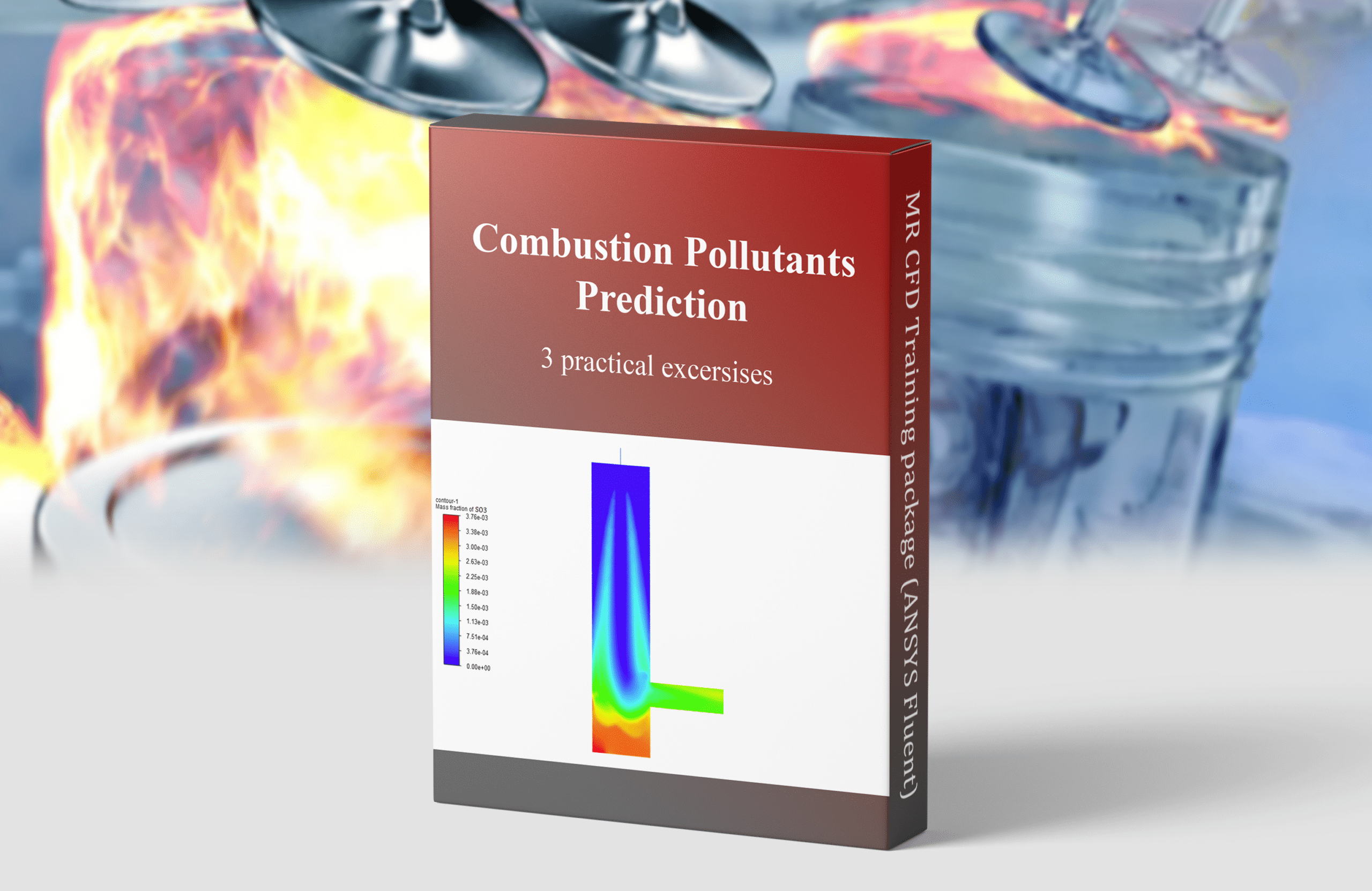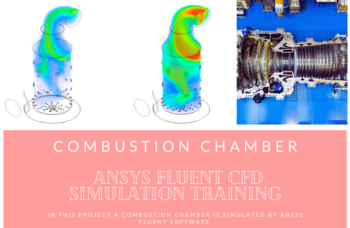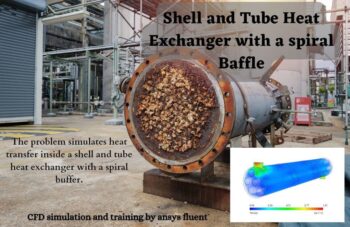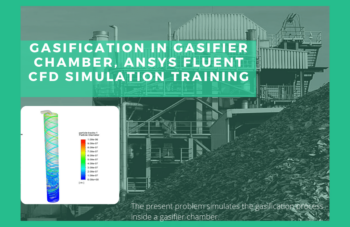Combustion Pollutants Prediction Training Package, 3 Learning Products
$320.00 Student Discount
Pollutants Prediction in:
- Combustion chamber
- Jet combustion
- Bluff-body mild burner
Click on Add To Cart and obtain the Geometry file, Mesh file, and a Comprehensive ANSYS Fluent Training Video.
To Order Your Project or benefit from a CFD consultation, contact our experts via email ([email protected]), online support tab, or WhatsApp at +44 7443 197273.
There are some Free Products to check our service quality.
If you want the training video in another language instead of English, ask it via [email protected] after you buy the product.
Description
Combustion Pollutants Prediction Training Package, 3 CFD projects
This combustion pollutants prediction training package includes 3 CFD projects to study pollutant prediction such as SOx, NOx, and Soot in a combustion chamber, jet combustion, and a bluff-body mild burner.
The projects are designed to help users understand the fundamentals of combustion pollutant prediction and to develop their skills in using CFD software to accurately predict the emissions from combustion systems. The projects include detailed instructions on how to set up the simulations, as well as guidance on how to interpret the results. The projects also provide a range of exercises to help users develop their understanding of the underlying physics and chemistry of combustion pollutant prediction.
The package also includes a comprehensive set of resources to help users understand the fundamentals of combustion pollutant prediction, including tutorials, case studies, and reference materials. The resources are designed to help users develop their understanding of the underlying physics and chemistry of combustion pollutant prediction, as well as their ability to interpret the results of their simulations.
Combustion pollutants prediction can be done using Computational Fluid Dynamics (CFD) simulations. CFD simulations are used to model the flow of air and combustion gases in an engine or other combustion system. The simulations can be used to predict the levels of pollutants such as carbon monoxide, nitrogen oxides, and particulate matter that are produced by the combustion process. The simulations can also be used to optimize the design of the combustion system to reduce the levels of pollutants.







Annamae Roob –
Can you tell me more about how the combustion pollutants are modeled in the software?
MR CFD Support –
In the software, combustion pollutants are typically modeled using detailed chemical reaction mechanisms that simulate the formation and consumption of various species during combustion. This involves solving complex chemistry and transport equations for species like SOx, NOx, and soot within the combustion chamber. The software uses specific models to represent different combustion regimes and pollutant formation processes, including premixed and non-premixed combustion models, NOx formation models like the Zeldovich mechanism, and soot models that account for nucleation, surface growth, coagulation, and oxidation. By accurately representing the physics and chemistry of combustion, CFD simulations can predict the levels of pollutants as part of the analysis output.
Miss Josefina Satterfield V –
I recently finished the combustion pollutants prediction training, and I must say I learned so much about SOx, NOx, and Soot prediction. The CFD projects were well-designed, providing not only hands-on experience with the software but also a deep understanding of the combustion process and pollutant formation.
MR CFD Support –
Thank you for your positive feedback! We are ecstatic to hear that our Combustion Pollutants Prediction Training Package was instrumental in deepening your understanding of combustion chemistry and pollutant prediction. It’s great to know that the projects were both informative and user-friendly. Keep up the good work applying what you’ve learned, and don’t hesitate to reach out if you need further assistance or more resources!
Prof. Tony Leannon –
I just completed the Combustion Pollutants Prediction Training Package and have to say, as an aspiring environmental engineer, it is an amazingly comprehensive learning experience with spot-on simulations and in-depth physical and chemical detail. Kudos to the MR CFD team for such valuable educational material!
MR CFD Support –
Thank you for your kind words! We’re thrilled to hear that our Combustion Pollutants Prediction Training Package met your educational needs and that you found it comprehensive and valuable. Our team strives to provide high-quality, detailed training materials to assist our users in expanding their expertise in advanced simulation topics. We appreciate your feedback and are grateful for customers like you!
Alicia Gorczany I –
I’ve just completed the Combustion Pollutants Prediction Training Package. From the methodology behind pollutant predictions to practical CFD applications, everything was clearly explained. The exercises were particularly engaging, solidifying the concepts and enhancing my simulation skills. The included resources were incredibly helpful for referencing and deepening my understanding. Great educational value for engineers in the combustion field!
MR CFD Support –
Thank you for your positive feedback! We’re thrilled to hear that the training package enhanced your understanding and skills in combustion pollutants prediction with its comprehensive approach. Embedding the concepts into practical exercises is fundamental to our teaching methodology. Keep using our resources, and we hope the knowledge you’ve gained will significantly benefit your projects and research in the field of combustion engineering.
Golda Haag –
I’ve gone through the training and it is very informative. However, can you please explain how the pollutants levels are quantitatively measured in the simulation? Is there a particular method or formula used?
MR CFD Support –
The quantitative measurement of pollutant levels in the simulation typically involves tracking the chemical species of interest and using reaction models that accurately replicate the combustion chemistry. Pollutants like SOx, NOx, and Soot are tracked through species transport equations and are dependent on the reaction mechanisms defined within the simulation. These specifics are often described in the case setup, where the user defines the reaction kinetics and species involved.
Freda Hoeger –
I’m a visual learner, does this training package include any visual aids like video tutorials or simulation animations to help me understand the concepts better?
MR CFD Support –
Yes, the Combustion Pollutants Prediction Training Package includes a variety of resources that cater to different learning styles, including those who prefer visual learning. The package offers instructional videos and animations that complement text-based materials, helping users visualize the simulation setup and interpret results more effectively.
Prof. Valentina Huel PhD –
This package seems thorough. Can one also learn to modify the combustion system design using this training to achieve lower emissions?
MR CFD Support –
Yes, the training package is designed to not only predict pollutants using CFD simulations but also to help users understand how to optimize combustion system design to achieve reduced emissions. Users could apply the concepts learned from the exercises and case studies to modify existing systems and evaluate the effectiveness of their design changes through simulation results.
Dustin Nicolas DDS –
This training package has been tremendously helpful in understanding how to predict and analyze combustion pollutants. The resources provided are thorough and accessible. Great work!
MR CFD Support –
Thank you for your kind words! We’re thrilled to hear that our Combustion Pollutants Prediction Training Package was useful in expanding your knowledge and skills in CFD and combustion analysis. If you have further inquiries or need assistance as you continue to explore this area of study, please don’t hesitate to reach out!
Jaron Larson I –
I bought the Combustion Pollutants Prediction Training Package, and it’s really thorough in content. The range of exercises helped me grasp the complex concepts of pollutant prediction in various combustion scenarios. The blend of theory and practical simulations using CFD was valuable for understanding and optimizing emissions. A really comprehensive learning kit!
MR CFD Support –
Thank you for taking the time to leave such a positive review! We are thrilled to hear that you found the Combustion Pollutants Prediction Training Package comprehensive and beneficial for understanding the intricacies of pollutant prediction in combustion processes. If you have any more feedback or require further assistance, don’t hesitate to reach out. Keep learning and discovering new insights with our products!
Prof. Alena Wunsch IV –
This package seems to cover a comprehensive range of topics in combustion pollutants prediction. Are there any prerequisites for this training package, or can beginners in CFD also start with it?
MR CFD Support –
The combustion pollutants prediction training package is designed to cater to a wide audience, including those who are new to combustion CFD analysis as well as intermediate learners. While the package is substantial and covers advanced topics, it begins with fundamental principles, making it suitable for motivated beginners in CFD. Simple knowledge of fluid mechanics and basic familiarity with CFD concepts might be helpful but is not strictly required to benefit from this training.
Prof. Carey Bernier V –
I’ve completed the training package and found it incredibly detailed. The exercises helped me grasp the intricacies of predicting combustion pollutants, and the tutorials made the learning curve much gentler. Highly recommended if you’re looking to dive deep into CFD and emissions analysis!
MR CFD Support –
Thank you for your positive feedback! We are thrilled to hear that the training package has proven to be helpful for your understanding of combustion pollutants prediction using CFD. We always strive to provide comprehensive learning materials to assist our users. Your recommendation is much appreciated!
Dr. Zelma Dibbert DVM –
I’ve just completed the Combustion Pollutants Prediction Training Package and I must say that the depth and practical approach of the CFD projects have significantly enhanced my understanding of emissions modeling. In particular, the exercises that walked me through the prediction of NOx in different combustion systems were enlightening. The comprehensive resources provided were invaluable. This is a complex domain and you guys nailed it by making it so accessible and pedagogic!
MR CFD Support –
Thank you for your kind feedback! We are thrilled to hear that our Combustion Pollutants Prediction Training Package was able to help enhance your understanding of emissions modeling. It’s fantastic that the resources provided were valuable to you and that the exercises made complex topics more accessible. We work hard to create educational material that is both informative and practical, so your comments are much appreciated. We hope you continue to find our products beneficial for your learning and practice in CFD.
Laurence Bogisich –
I’m extremely impressed with the Combustion Pollutants Prediction Training Package! It gave me a comprehensive understanding of how to set up and run simulations for different combustion systems. The results from these projects have been accurate and closely reflect what you’d expect in real-world scenarios.
MR CFD Support –
Thank you so much for your positive feedback! We’re thrilled to hear that our Combustion Pollutants Prediction Training Package has provided you with valuable insights into CFD simulations for pollutant predictions in combustion systems. Your understanding and successful application are precisely what we aim for. If you need any further assistance or advanced training, please feel free to reach out to us.
Ms. Meggie Grady Sr. –
I’ve just finished all three projects in the Combustion Pollutants Prediction Training Package. Not only did I gain a comprehensive understanding of the complexities involved in modeling combustion processes and predicting emissions, but I also greatly appreciated the depth and clarity of the tutorials provided. How solid and up-to-date is the science behind the chemical models used for these predictions?
MR CFD Support –
Thank you for your positive feedback! The chemical models used for these CFD simulations in the Combustion Pollutants Prediction Training Package are based on contemporary reaction mechanism theories that are widely accepted in the combustion research community. The models incorporate the latest data on reaction rates and species interactions, ensuring accurate predictions of combustion pollutants. We regularly update our training materials to reflect any advancements in the field, so you can be assured you’re working with the state-of-the-art tools and knowledge.
Dr. Casper Wilkinson PhD –
I recently finished the MR CFD Combustion Pollutants Prediction Training Package and all I can say is wow! The range of exercises, detailed instructions, and comprehensive resources provided deep insights into the complexities of pollutant formation. The projects were well-structured, guiding me through various scenarios from a combustion chamber to jet combustion, and finally to a bluff-body burner. Understanding the chemistry and physics of combustion has never been more interactive and practical. This package does more than just teach; it immerses the user in a thorough learning experience!
MR CFD Support –
Thank you so much for your kind words and positive feedback! We’re delighted to hear that you found the Combustion Pollutants Prediction Training Package both enlightening and interactive. Our goal is always to provide valuable and comprehensive learning experiences, and knowing it benefitted your understanding of combustion pollutants is incredibly rewarding for us. We appreciate you taking the time to share your experience and we look forward to serving you more educational content in the future.
Esta Kuhn –
The training package is fabulously comprehensive and clearly designed with the learner in mind. The problem statements are engaging, and the systematic approach to predicting combustion pollutants is exceptional. Working through the projects has significantly enhanced my grasp of underlying chemical processes during combustion and how to link these to CFD outputs.
MR CFD Support –
We’re thrilled to hear that our Combustion Pollutants Prediction Training Package has been so beneficial to you! Thank you for your kind words. It’s gratifying to know that our comprehensive approach and resources have enhanced your understanding of combustion chemistry and pollutant prediction in CFD simulations. We appreciate your feedback and wish you continued success in your CFD studies!
Ottilie Schneider MD –
I’ve completed the Combustion Pollutants Prediction Training Package and found the projects to be extremely informative. The range of tutorials and case studies provided a deep understanding of the physics involved in combustion processes and pollutant formation. They were well-structured, making the learning experience very rewarding.
MR CFD Support –
Thank you for your positive feedback on our Combustion Pollutants Prediction Training Package! We are thrilled to hear that you found the materials to be informative and helpful in understanding the complexities of combustion and emissions. We aim to continually provide comprehensive and intuitive learning experiences. Should you have any further inquiries or need additional support in your learning journey, please don’t hesitate to reach out.
Rowland Cronin –
I have gone through the training materials for pollutant prediction, and the depth of content you provide is impressive. Each project deepened my understanding of the complexities involved in combustion processes and helped me get comfortable with using CFD for such analyses.
MR CFD Support –
Thank you for your kind words and positive feedback on the Combustion Pollutants Prediction Training Package. We are delighted to hear that our training materials were able to help enhance your understanding and skills in this complex field. Your successful learning experience is exactly what we aim for with our learning products. If you ever have any further questions or require assistance with advanced topics, do not hesitate to reach out!
Dr. Jocelyn Senger V –
I recently completed the Combustion Pollutants Prediction Training Package and the detailed guidance provided was invaluable. The variety of projects really enhanced my understanding of different combustion scenarios and using CFD to predict emissions was both challenging and rewarding.
MR CFD Support –
Thank you for your positive feedback! We’re thrilled to hear that our Combustion Pollutants Prediction Training Package was helpful in enhancing your understanding and skills in emission prediction using CFD simulations. Your experience with the variety of projects is exactly what we hope for our users. If there’s anything further we can assist you with in your learning journey, please let us know!
Frieda Monahan –
I’ve purchased the Combustion Pollutants Prediction Training Package. Can I apply the learning from these projects to other combustion models outside automotive applications?
MR CFD Support –
Absolutely! The principles and techniques that you learn from the Combustion Pollutants Prediction Training Package are applicable to various types of combustion systems beyond automotive applications. You’ll gain a deeper understanding of the pollutant formation mechanisms and how to simulate these using CFD, which can certainly be transferred to a broad range of combustion-related scenarios. Whether it’s industrial burners, power generation units, aerospace applications, or environmental studies, you’ll be equipped to tackle the challenges in predicting combustion pollutants with confidence.
Ms. Mallie Hayes –
The Combustion Pollutants Prediction Training Package was incredible! Starting from the basics and escalating to complex simulations, I’m now much more adept at using CFD for emission studies. I loved the proactive approach through exercises and detailed resources.
MR CFD Support –
Thank you for your kind words! We’re thrilled to hear that the training package has equipped you with the knowledge and tools needed to excel in CFD for combustion pollutant prediction. Your success with the exercises and resources is exactly what we aim for. Your feedback is highly appreciated!
Matilda Bergstrom DVM –
What an intriguing set of CFD projects! The in-depth approach to learning about pollutant prediction in different combustion scenarios is really useful for someone like me who’s looking to understand and eventually reduce emissions from combustion systems. The inclusion of exercises enhances the learning experience by providing practical hands-on practice.
MR CFD Support –
Thank you for your kind words! We’re delighted to hear that you’re finding our Combustion Pollutants Prediction Training Package valuable for understanding the complexities of emissions. It’s great to know the hands-on exercises are enhancing your experience. Should you have any questions or need further support, feel free to reach out. We’re here to help you on your journey to mastering CFD and pollutant control.
Missouri Yundt I –
I just completed the Combustion Pollutants Prediction Training Package and found it incredibly informative. The detailed instructions and exercises really enhanced my understanding of how to model pollutants in various combustion systems. The inclusion of case studies was particularly useful as it provided a practical perspective to the theoretical knowledge. Thanks for a well-structured learning experience!
MR CFD Support –
Thank you for taking the time to share your feedback! We’re thrilled to hear that our Combustion Pollutants Prediction Training Package was informative and helped deepen your understanding of combustion pollutants simulation. Your endorsement means a lot to us, and we are glad that you found the practical aspects of the case studies useful. If you have any questions in the future, or if there’s any other way we can assist you, please do not hesitate to reach out!
Joseph Thiel –
The projects are wonderful learning tools. The step-by-step setup procedures, supplemented by exercises and comprehensive learning materials, solidified my understanding of combustion pollutant prediction. It’s fascinating to actually predict emissions through simulations and see theory translate into practical applications.
MR CFD Support –
Thank you for your positive feedback! We’re glad to hear our training package has contributed to your understanding of combustion pollutant prediction and practical application of CFD simulations. If you have any more questions or need further assistance in your learning process, don’t hesitate to reach out.
Gerard Donnelly –
I am really impressed with the combustion pollutants prediction package. It offered comprehensive resources that helped me enhance my understanding of the intricacies involved in predicting emissions from combustion systems. The exercises provided were challenging and rewarding, allowing me to apply the concepts in practice. Glad to have found this training package!
MR CFD Support –
We’re thrilled to hear that our Combustion Pollutants Prediction Training Package met your expectations and was instrumental in advancing your knowledge and skills. Thank you for taking the time to provide such positive feedback. Your success is our goal, and we hope our resources continue to support your learning journey!